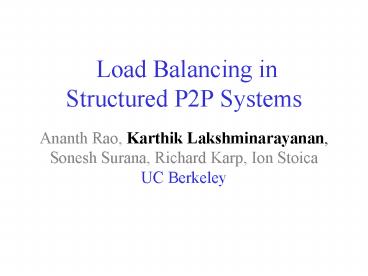Load Balancing in Structured P2P Systems - PowerPoint PPT Presentation
1 / 23
Title:
Load Balancing in Structured P2P Systems
Description:
Light nodes report their load information to directories. ... Directories periodically compute the transfer schedule and report it back to the ... – PowerPoint PPT presentation
Number of Views:34
Avg rating:3.0/5.0
Title: Load Balancing in Structured P2P Systems
1
Load Balancing in Structured P2P Systems
Ananth Rao, Karthik Lakshminarayanan, Sonesh
Surana, Richard Karp, Ion Stoica UC Berkeley
2
Goals and Assumptions
- Goal To maintain the system in a state in which
load on a node is less than its target. - Load Depends on the particular P2P system.
- E.g. Storage, Network bandwidth.
- Target Maximum load a node is willing to hold.
- Assumptions
- Nodes of the P2P system are co-operative.
- Only one bottlenecked resource, e.g. storage,
network bandwidth.
3
Outline
- Motivation and Preliminaries
- Load balancing algorithms
- Evaluation
4
Need for Load-Balancing
- Choice of identifiers determines the node the
objects are mapped to. - Objects and nodes are assigned IDs at random.
- Leads to O(log N) imbalance in the load of a
node. - Problems
- Sizes of objects might not be the same.
- Object IDs might not be chosen at random.
- Heterogeneity in the capabilities of nodes.
5
Virtual Servers
- Contiguous region of the ID space.
- Each node can be responsible for many virtual
servers. - Used in Chord/CFS.
6
Virtual Servers
- Contiguous region of the ID space.
- Each node can be responsible for many virtual
servers. - Used in Chord/CFS.
Node A
Node B
Node C
Chord Ring
7
Static Mapping of Virtual Servers
- Imbalance Instantiate log N virtual servers at
each node leads to constant factor imbalance. - Heterogeneity Number of virtual servers is
proportional to nodes target (e.g. CFS).
Node A
T50
Node B
T35
Heavy
Node C
T15
Chord Ring
8
Dynamic Mapping of Virtual Servers
Allow dynamic re-mapping of load in a
system. Virtual server is the basic unit of load
movement.
11
20
Node A
T50
15
3
Node B
T35
Heavy
Node C
10
20
T15
Chord Ring
9
Dynamic Mapping of Virtual Servers
- Allow dynamic re-mapping of load in a system.
- Virtual server is the basic unit of load movement.
11
20
Node A
T50
15
3
Node B
T35
Node C
10
30
T15
Chord Ring
10
Advantages
- Flexibility in being able to move load from any
node to any other node in the DHT. - Schemes proposed so far are restrictive in
transferring load only to neighbors in the DHT. - Movement of virtual servers appears as a join
followed by a leave supported by all DHTs.
11
Virtual Server Transfer An Example
Heavy!
Load 13, Target 10
Node A
6
3
4
4
2
Node B
Load 6, Target 10
Light
12
Virtual Server Transfer An Example
Light
Load 10, Target 10
Node A
6
4
3
4
2
Node B
Load 9, Target 10
Light
Splitting of virtual servers not done.
13
Outline
- Motivation
- Load balancing schemes
- Evaluation
14
Scheme 1 One-to-One
- Light node picks a random ID, contacts the node x
responsible for it, and accepts load if x is
heavy.
15
Scheme 2 One-to-Many
- Light nodes report their load information to
directories. - Heavy node H gets this information by contacting
a directory. - H contacts the light node which can accept the
excess load. - Implementation Directories are stored in the
nodes of the DHT.
16
Scheme 3 Many-to-Many
- Many heavy and light nodes rendezvous at each
step. - Directories periodically compute the transfer
schedule and report it back to the nodes, which
then do the actual transfer. - Advantages Best-fit heuristic reduces
fragmentation of capacity.
17
Outline
- Motivation
- Load balancing algorithms
- Evaluation
18
Simulation Setup
- Three schemes were simulated for up to 32,000
nodes, and compared along 2 metrics - Load transferred to achieve balance.
- Time to achieve balance.
- Distributions chosen
- Target of nodes Pareto.
- Loads on virtual servers (i) Gaussian (ii)
Pareto.
19
Metric 1 Total Load Transferred
- Total load transferred
- Load moved depends only on distribution of loads,
and the target to be achieved and not on the load
balancing scheme. - Operational range
- Many-to-many scheme is able to produce balance
even at very high system load (when load is up to
a fraction of 0.94 of capacity). - Other two schemes work only up to a factor of
about 0.8.
20
Metric 2 Time taken for Balance
One-to-one scheme may be sufficient if control
traffic overhead does not affect the system
adversely.
21
Other Results
- Size of the directory
- How many heavy and light nodes must come together
to keep the total number of probes small? - Most heavy nodes shed their load by making only
one probe, for number of nodes per directory as
low as 16. - Performing Swaps
- Move load out of a light node to accommodate a
heavy virtual server. - Benefit only when allowed imbalance is extremely
small.
22
Why Not Caching?
- Potential problems
- Does not work for certain resources, e.g.
storage. - Need to maintain cache consistency.
- Large number of active small objects.
- E.g. DB applications.
- Need to push out all of them for caching to be
effective. - Orthogonal and complementary to our schemes.
23
Questions?































